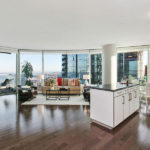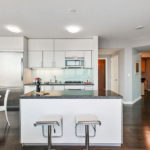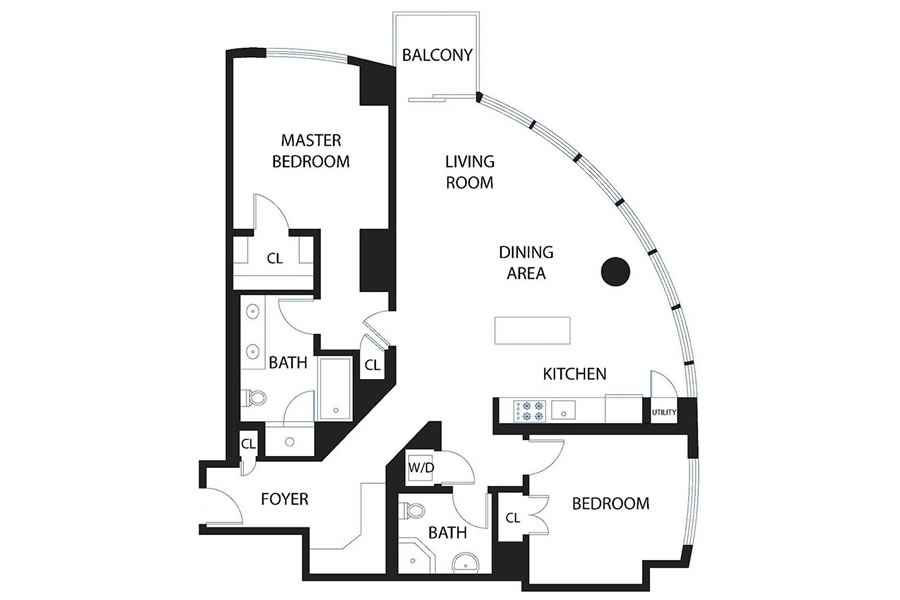Purchased for $2.199 million in December of 2015, establishing a building and neighborhood comp at roughly $1,662 per square foot, the two-bedroom condo #28F in the first Infinity tower at 301 Main Street returned to the market listed for $1.999 million this past January and was briefly in contract at the end of that month.
Beyond its two bedrooms, the “pristine” condo with bay and city views is outfitted with a built-in office area, two baths and a designated parking space in the garage below.
And with a list price which was reduced to $1.899 million in March, and then to $1.82 million two weeks ago, the sale of 301 Main Street #28F has now closed escrow with a contract price of $1.775 million or roughly $1,342 per square foot, which is officially “within 3 percent of asking” on account of the aforementioned list price reductions.
And while $1,342 per square foot certainly isn’t cheap, it is 19.3 percent cheaper versus the fourth quarter of 2015 on an apples-to-apples basis.







That bathroom was outdated upon completion.
I’ve visited a few units in Infinity, and they are aging badly. I think the “look” they selected was just about to go out of style, because the units don’t look very attractive for such a high price – especially with Lumina right next door.
Geez, they lost over half a million dollars in less than three years. That’s worse than most people lost during the financial crisis.
And that’s with Facebook, Google, Apple and others going gangbusters and a very healthy IPO market. What happens when that music stops?
I don’t see the music stopping – more likely just slowing down. This is a bit of an outlier as condo prices are down, IIRC, about 11% from their 2015 peak. This is a little worse than the average but the fulcrum for the downturn seems to be Infinity and Lumina so not surprising.
It’s developers/LLCs whose projects are entitled or in the process of who are in choppy waters and the Infinity is a poster child for that. If condo prices remain flat or up slightly for the coming 5 years or more many of these projects “don’t pencil”. It’s words to that effect that the developer of the 1274 Mission tower used to expain why they aren’t moving forward with the project. Of course the indefinite, if not permanent, delay in getting HSR to the TTC and also CalTrans takes away a lot of the luster of being in SOMA. Without that nexus there is probably not going to be a bustling retail presence in and around TTC.
I expect many more entitlements to be put on the market and investors in those are going to take a hit. The timing for Parcel F is not good. They seem to slow-walking it and maybe this is why. Does the residential component of that project even pencil now? Re-sales such as this at the Infinity would suggest perhaps not.
Not sure how CalTrans takes away from being in SOMA other than I-80 freeway that’s been there for last half-century.
Should have been more precise. Caltrans not coming to the TTC until 2035 or later just confirms the TTC’s status as the world’s most expensive bus station. The hoped for Grand Central, more realistically LA’s Union, type nexus will not come to be for a long time if ever. The retail component of the TTC will not be near as vibrant as it would have been if trains had actually come to the station. That’s why so many of the projects had hotel components (Crescent, the Claw, Parcel F and more) – to service a tourist destination. Of course, “luxury” condos were to be a part of this grand neighborhood. Now that the hood won’t be so quite so grand, the condos lose some of their cache and prices are falling/stagnant..
I think you mean CalTrain : “Caltrans” = (CA State) Department of Transportation
It doesn’t help that 100 Folsom is going to block every north facing view at The Infinity.
$1300 per SF for quarter round trim at the baseboard instead of replacing all the baseboard with the new floor? Throw in the apron bathtub and the visible wires to wall mounted TVs, and it just sweetens the deal.
The TL;DR here is:
1) If your hypothesis was that the price rise on the upswing was purely due to fundamentals, then what significant drop in fundamentals can you point to to account for the deceleration in prices from rocketing up at a double digit rate to a plateau (or even decline)? (Prices here will never stop rocketing up unless we give up our smart phones, have a depression, Korean war, ….)
2) If you believed in the “magic feather” theory of SF RE, when exactly does the “magic feather” kick in? The “magic feather” being one of the many pet theories floated around as to why this particular boom wouldn’t bust ( Apple/Google hitting a magic critical mass, Chinese investors, SF’s great weather, millennials “discovering” urban living, Some IPO/hot startup,…)
And remember that in parallel to the cycle in demand/prices, there is also a cycle in lending behavior. At the beginning of this cycle, the focus was on a strict adherence to 20%+ down to make sure buyers had skin in the game. And we steady saw that weaken all the way back to zero down loans. When prices are rising rapidly buyers really do get ‘instant equity’ and low/no down loans are low/no problem.
But remember that all of these ‘bad apples’ act as comps. 20% below 2015 right now is at the vanguard of price declines, but there have been other recent sales with 2015 era pricing (And remember that not too long ago, the idea of even revisiting 2016 pricing was heretical) These comps feed back into the valuation of loan portfolios. And an environment where homes can be underwater even 3-4 years after purchase is much less hospitable to low/no down lending.
so much wasted space in that little hallway that connects the master bedroom and bathroom